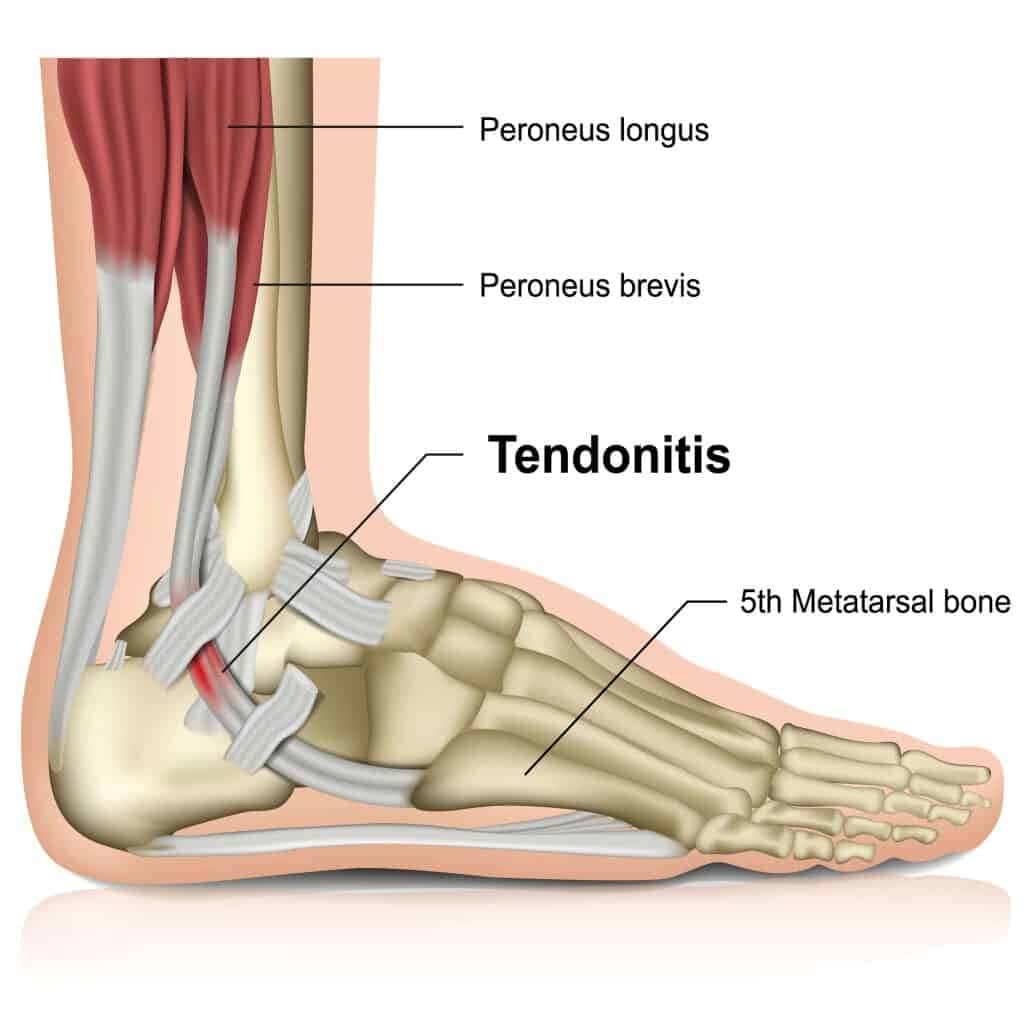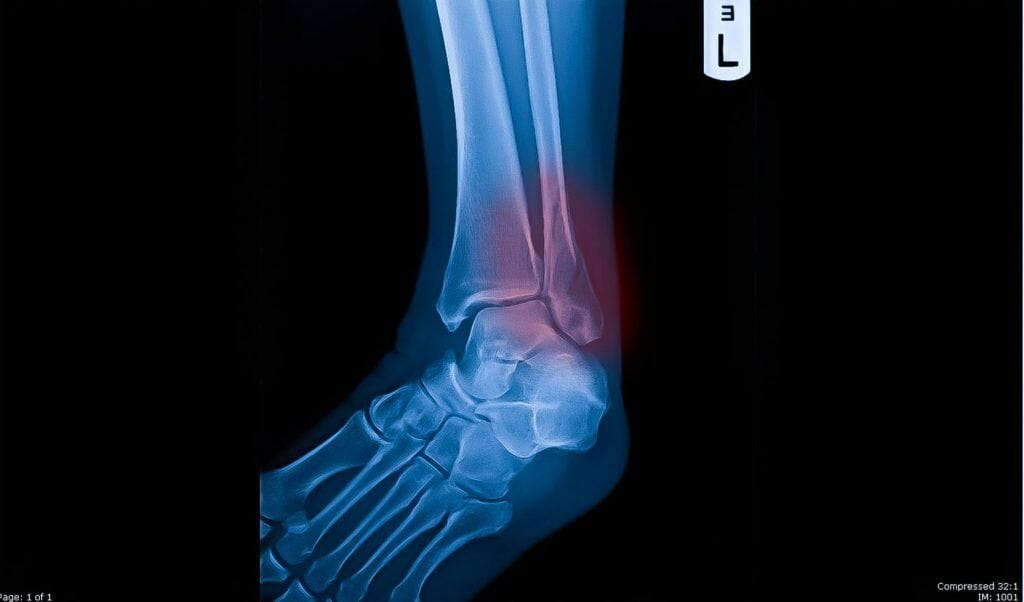Outside Ankle Pain: Running, Standing, Walking
- Best Asics Shoes for Flat Feet - October 25, 2024
- Best Running Shoes for Flat Feet - October 22, 2024
- Posterior Tibial Tendonitis - October 21, 2024
Outside ankle pain is common in runners and all walks of life. Numerous structures and conditions can cause outer ankle pain, and in this article, we will cover the signs, symptoms, and treatment of some of the more common conditions that lead to outer ankle pain.
Causes of Outside Ankle Pain Running
Lateral Ligament Sprain
There are 3 main ligaments on the outside of the ankle. Their primary function is to provide stability to the outside of the ankle and provide stability on uneven surfaces. The lateral ligaments of the ankle are some of the most commonly sprained ligaments in the body, especially the Anterior Talofibular ligament (ATFL) and the Calcaneofibular Ligament (CFL).
These ligaments are most often injured through inversion or inward rolling of the ankle joint. Tears of ligaments are graded from 1-3, with 3 being the worst. A clinical diagnosis can be achieved through a consultation with a Physical Therapist or a Sports Medicine Doctor. They may refer for an Ultrasound scan or an MRI to confirm the diagnosis if uncertain.
Ice and early mobility are recommended in the acute stage, while high-graded tears may be placed in an ankle brace. Treatment consists of graded strengthening and mobility exercises guided by a Physical Therapist.
Sinus Tarsi Syndrome
Sinus Tarsi Syndrome is a painful condition outside the ankle that can sometimes be confused with a lateral ankle sprain. The subtalar joint consists of two bones, the talus and the calcaneus. The Sinus Tarsi is a small tunnel that passes through the articulation of these bones. Within this tunnel, there are nerves, tendons, sinus tarsi ligaments, and blood vessels that, when irritated, can become painful. This may be the result of trauma to the area or from an unstable ankle.
Sinus Tarsi Syndrome symptoms include pain and tenderness over the area, often aggravated by walking on uneven surfaces, impact, and standing for long periods.
Treatment includes physical therapy, taping, footwear advice, and strengthening and balance exercises. If this fails to settle the symptoms, a steroid injection may be required.

Peroneal Tendonitis or Peroneal Tendon Tear
Three peroneal tendons run along the outer side of the shin bone, across the lateral ankle, and connect to the outer and underside of the foot. Their main function is to turn the foot out and down while acting as a stabiliser of the foot and ankle through motion. If they become overused through repetitive motion, such as walking or running, they can become inflamed and painful, leading to Peroneal Tendonitis. Similarly, a sudden inversion of an ankle can cause a Peroneal Tendon Tear.
In the acute phase, Peroneal Tendonitis may be painful with all movements. In less acute episodes, it may be stiff and tender in the morning. During activity, it may be tender initially but ease as it warms up. As the condition becomes more chronic, it can become constantly painful. Peroneal Tendonitis is a common cause of outside ankle pain without swelling.
Treatment with a Physical Therapist or a Sports Medicine professional is recommended. The best treatment for Peroneal Tendonitis is strengthening exercises and footwear modification combined with modification to activity levels. Insoles, braces, and taping can provide temporary relief.
Lateral Malleolus Stress Fracture
The lateral malleolus, the distal fibula, is a common site of ankle stress fractures. It is more prevalent in high-impact activities but can occur innocuously in those with low bone density or vitamin D levels.
Lateral Malleolus Stress fracture symptoms often include a sharp pain around the outside of the ankle when walking, weight-bearing, or running. There may be some swelling and bruising in the area. An Orthopaedic consultant may refer you for an x-ray to confirm the diagnosis. An MRI or CT Scan may be required if this returns as normal.
Treatment typically consists of 4-6 weeks in a walker boot and 4-6 weeks of Physical Therapy.

Other Causes of Outside Ankle Pain
It is possible to sprain some of the lesser-known ligaments, such as the Bifurcate ligament, during a lateral ankle sprain. Its function is to stabilize the ankle slightly further down than where you would see a typical ATFL injury, and it’s a less common but often misdiagnosed injury. So, most clinicians might look at a typical ankle sprain, think it’s the ATFL ligament, and work through the rehab process, but miss out on the Bifurcate ligament sprain which often coexists alongside a fracture to the anterior process of the calcaneus.
This is the attachment side of the Bifurcate ligament, and in some cases, the ligament pulls off a fragment of the bone, resulting in an avulsion fracture. This can be one of the reasons you get prolonged pain slightly further than the ankle after a lateral ankle sprain.
Other causes of outer ankle pain include Subtalar Joint Osteoarthritis. So, the Subtalar Joint helps to turn the ankle inward and outward. Due to a history of trauma or previous instability of the ankle, or just general changes over time, we can get arthritis in the joint. This typically presents without a specific mechanism of injury; often, we see stiffness first thing in the morning or after we get up from sitting for some time. It can be a bit generally achy, resulting in a reduced range of motion of the ankle joint. As we try to increase activity levels, the pain often increases alongside it, so it is not a pleasant injury overall.
The final cause of ankle pain may be a Tarsal Coalition. We know they exist in about 13% of cases, and it’s normally the result of when we’re born; the bones don’t typically separate the calcanonavicular joint. As a result, they’re not as mobile as you might like them to be, and they can become painful from overload or a lateral ankle sprain. However, in many cases, patients can go their entire lives without knowing they have a tarsal coalition.
Related Articles
What exercises can I do with Peroneal Tendonitis – Footwear for 5th Metatarsal Fracture – Foot Pain Chart
Feel Good, Move Well, Be Better
